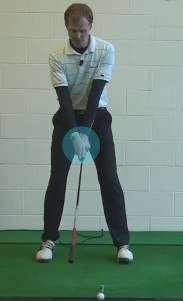
Ideally, the clubhead reaches maximum speed at the bottom of your swing. Accelerating into and through the ball is the key to pounding long, straight drives.
The classic “whoosh drill” can be done any time, any place – no ball required.
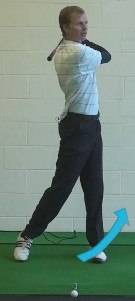
Note where your "whoosh" is loudest. If you're accelerating correctly, it will be at the bottom of your swing. If it comes on the backswing, you're too quick going back and decelerating coming down. If it comes at the beginning of the downswing, you may be “casting” the club from the top.
Achieving full, well-timed acceleration requires a proper sequencing of the lower and upper bodies, with the hips leading the downswing. Work on this action using the “whoosh drill” until you hear that magical sound, time after time, as your swing bottoms out.
This drill is also recommended for improving and maintaining your balance and tempo.
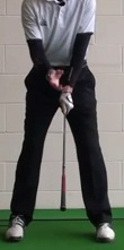
Use Whoosh Drill to Hit Longer Drives
Adding yards to your drives is going to help nearly every aspect of your game. Obviously, your tee shots will be longer, meaning you will be able to avoid more of the obstacles that are placed in front of you alongside the fairways. Your approach shots will be shorter as well, so your iron and wedge game is likely to be more productive. Finally, you will be setting up shorter birdie and par opportunities, meaning you should see more putts fall in as well. When you look at it this way, it's easy to see why so many people are serious about adding distance to their drives. Picking up even just a few yards can go a long way toward making you a significantly better player.
One of the best ways to add yards off the tee is through the use of drills. Some simple swing drills that are designed to help you improve on the fundamentals of your swing will allow you to make real progress during your practice sessions. It is easy to stand out on the driving range hitting balls without having much in your mind – but that kind of 'practice' really isn't going to make you any better. Instead, head to the range with a purpose and direction for what you are going to do with your time. Simply by having a drill or two ready to use while on the range, you can make progress toward becoming the best player you can be.
In this article, we are going to look at a drill that is designed to help you hit longer drives – the 'whoosh' drill. The name of this drill really says it all, as you are going to attempt to make a whooshing sound with the club while you make some practice swings. Since you don't actually hit the ball with this drill, it can be done anywhere that you have space to swing the club safely. So, while this drill would make a nice addition to your driving range routine, it would be just as beneficial if done in your backyard when you have a few spare minutes. In fact, you can even do this drill on the tee before you tee off, as nothing about it will violate the rules of golf.
If you have ever worked with any other golf drills in an attempt to improve your swing, you already know the following to be true – the simple drills are the best. It is tempting to get deep into a highly technical drill, thinking you will make progress just because of all the complexity that the drill presents. That usually isn't how it works, however. More likely, a complicated drill is only going to get in your head, causing you to think more than you should during the swing. Stick to simple options like the whoosh drill to keep your mind clear while you improve your game one practice swing at a time.
All of the content below is based on a right handed golfer. If you happen to play left handed, please take a moment to reverse the directions as necessary.
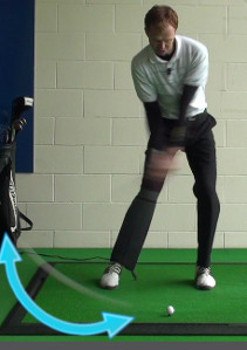
It's All About Acceleration
The objective of the whoosh drill is to confirm that you are accelerating the club at the perfect time within your swing. Unfortunately, most amateur golfers are not doing this correctly at the moment, as the average player wastes their acceleration prior to reaching the hitting area. It should go without saying that you want to be accelerating the club just as impact arrives, as this is going to lead to the greatest transfer of energy from the club into the back of the ball. If you should happen to waste your acceleration earlier in the swing, you will always fall short of your distance potential with the driver (and the rest of your clubs as well).
Generally speaking, there are two points during the swing where the typical amateur golfer is prone to waste their acceleration. Those two points are listed below -
- Early in the backswing. When you get your swing started, the club should be moving slowly and steadily away from the ball. If you rush into your swing as so many players do, you are actually going to waste acceleration early in the going. There is no point in swinging the club fast on the way back, as that energy is not going to be carried over into impact where it matters. Speed you create in the backswing is guaranteed to be wasted, so you will be better off swinging slowly to start while saving your acceleration for the point in the swing when it matters most.
- Early in the downswing. The player who wastes his or her speed early in the downswing is a little bit closer to getting things right, but they are still a bit off track. Many golfers refer to acceleration that takes place early in the downswing as 'casting' because of the way your hands and wrists cast the club up over top of the proper swing plane. This is a mistake that is commonly associated with the slice, but it is possible to cast the club without actually hitting a slice. From the top of the swing, your goal should be simple – to save your acceleration for the last possible moment prior to impact. By holding the angle and saving acceleration for the bottom of the swing, you will have a great chance to produce a powerful, effective strike.
One of the most important things you can do in the golf swing is to avoid making a mistake at either of the two points listed above. If you can successful avoid acceleration both early in the backswing and early in the downswing, you should have plenty of energy saved up for impact. Unfortunately, making this change is not going to be particularly easy for the average golfer. Millions of players suffer from a miss-timed acceleration in the swing, which is why the whoosh drill can be so effective. This is an extremely simple drill that still manages to address the needs of a large percentage of the golfing population.
So, how do you know if you are wasting your acceleration early in the swing? While you can look at video of your technique to check for this mistake, you probably don't even need to go that far. If you feel like you hit the ball shorter than most of the people you play with, and those people are similar to yourself in terms of age and physical capability, it is almost certain that you are wasting your acceleration. Even if your timing is already quite good, there will be no harm in using the whoosh drill anyway. This drill isn't going to set you back in any way even if you don't really need it – so feel free to read on and add this basic drill to your golf 'toolbox'.

Performing the Drill
As was mentioned earlier, you aren't going to be hitting shots with this drill, so there is no need to be at the driving range. Of course, you can certainly do the drill if you are at the range, but you can just as easily perform it at home (in a space where you have room to swing safely). While it is possible to do the drill with any of the clubs in your bag, the best bet is to opt for the driver. Since the driver has the longest shaft of any of your clubs, it is going to make the loudest 'whooshing' sound as you swing. If you don't have a driver available for some reason, simply opt for the longest club that you do have in the bag.
To get started, you are actually going to turn the club upside down. Flip the club over and form your grip just below the head of the club, rather than on the grip itself. The grip end of your driver should be down at the ground. Place your hands on the shaft of the club just as you would when holding on to the grip end. Also, be sure to use your normal stance, taking a moment to get into a great address position over the imaginary ball. Once you have your hands in place and your stance set, you will be ready to make your first swing.
On the first swing, don't consciously try to do anything different from your usual technique. Just make a golf swing, and listen for the swoosh noise. If it helps you to focus on the sound that is made by the club, you can even close your eyes during the swing. The important thing to determine is exactly when it is that the grip end of the club makes a whooshing noise as it cuts through the air. The timing of the sound is going to be the determining factor in whether or not you have been successful with this drill.
You can probably guess that the point at which you hear the whooshing sound is going to be the fastest part of your swing. It takes a fair amount of speed in the swing for the club to make a noise at is cuts through the air, so you can be confident you are accelerating nicely when you do hear the whoosh. Hopefully, you are going to hear the noise right at the bottom of your swing. In fact, since it takes a split second for the sound to travel up to your ears, you might feel like you are hearing it after you have swing through the impact area. That is a perfect result, if it is the one you achieve. Should you find that your natural swing creates a whooshing sound at the bottom of the swing, you are all set to go. There is no need to worry about this drill any further, as you already have it mastered.
Of course, that is not going to be the story for most golfers. Instead, the average player is going to hear the whooshing sound much earlier in the swing. Some will hear it during the backswing, while many will hear it early in the downswing. It is important to note the exact point at which you hear the noise, as that information will be helpful when trying to fix your swing mechanics. Make several swings in a row with the whoosh drill to make sure you have centered in on the point in your swing where the club is moving at its fastest.
When doing this drill at home, you really won't be able to go much farther at this point. After all, you can't transition into hitting some practice shots, so you will be limited to making a few swings with the whoosh drill (unless you have other practice equipment at home). On the other hand, if you are at the driving range already, you can move right into trying to make the necessary fixes to get your swing on track.
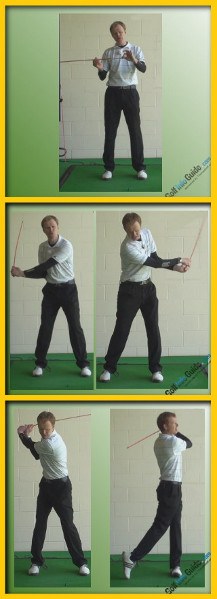
Moving the Whoosh
In this section, we are going to take a close look at the adjustments you can make in order to move the whooshing sound to precisely the right point in the swinging action. You shouldn't expect to fully make the necessary changes in a single practice session, but you can certainly do your best to take a step in the right direction.
The corrections that you need to make are going to be based on the point in the swing that is currently creating the whoosh. Using the information you gained while performing the drill, select the right instruction for your needs from the two options below.
- Whoosh early in the backswing. If your swing is creating a whooshing sound early in the backswing, we need to find a way to slow down your takeaway. Usually, golfers take the club back too quickly when they engage their hands in the takeaway process. Your hands should have almost nothing to do with the takeaway, so this is a clear-cut problem to correct. By not allowing your hands to get involved in the swing, you should be able to slow things down going back and take the whoosh out of your takeaway. To successfully take your hands out of the takeaway, you are going to pay attention to the positioning of the back of your right hand. Your right wrist is sure to bend backward if you are using your hands early in the backswing, so don't allow that to happen. Turn away from the target using shoulder rotation rather than hand action and you will be on the right track. As long as you have a smooth tempo to go along with your quiet hands, the whooshing noise should quickly be taken out of your backswing.
- Whoosh early in the downswing. Correcting the whoosh that occurs early in your downswing is going to be quite a bit harder than fixing the whoosh in the backswing. There are a lot of complicated mechanics taking place at this point in the swing, meaning the fixes can get rather technical in nature. However, there is one way you can work on fixing this mistake which is rather simple and straightforward. By trying to make your backswing wider, you can give yourself more room to start the downswing correctly – and you just might be able to delay the acceleration of the club as a result. During your backswing, work on keeping your left arm extended all the way up to the top of the swing. Many golfers allow the left arm to collapse, bringing the club in close to their body in the process. This might not seem like an issue right away, but it becomes a big problem at the top of the swing. With your hands in tight to your head – and often just above your shoulder – you will have to 'cast' the club over the top just to swing down toward the ball. When that happens, you are likely to speed the club up prematurely. The whoosh will happen too early, you will have wasted your speed, and your shot will lack power. Avoiding all of those problems can be as simple as maintaining width throughout the backswing. Focus on the movement of your left arm and everything else may fall into place nicely.
It is one thing to read about the corrections that you need to make to your swing – it is another thing entirely to actually make those fixes. To have success with the challenge of moving the whoosh down to the bottom of your swing, it is important that you are determined and patient right from the start. Plenty of golfers give up after getting frustrated with this process, but giving up is obviously not going to get you anywhere. Tell yourself that you are going to see this through all the way to the end, and you just may come out on the other side with a vastly improved golf swing.

Short Game Application
In the short game, you aren't going to be swinging the club fast enough (on most of your shots) to create a whooshing sound. Therefore, you really won't be able to do this drill specifically in the short game, as you can't learn anything from the drill if the club doesn't make a noise. However, you can learn from the concept that this drill is teaching, which is the fact that you need to accelerate the club at the bottom of the swing on all of your shots.
Many golfers don't think that they need to accelerate the club in the short game, since distance is not one of their top priorities. Those golfers are mistaken. Acceleration is just as important in the short game as it is on any other shot. Without acceleration, you are going to have a hard time hitting your target line, and you are going to have difficulty judging your distance as well. The best short game players are committed to accelerating the club properly through the ball, and you should follow their lead.
One of the keys to enabling acceleration in your short game is to keep your backswing as tight as possible. This is true both with your chipping swing and your putting stroke. If you take the club back too far for the shot at hand, you are going to have to decelerate the club just to avoid hitting the shot too far. This is an extremely common mistake among amateur golfers, and it is a big part of the struggles that amateurs have on and around the greens. Simply by tightening things up and avoiding a long backswing, you can quickly improve your short game play.
To work on this point on the putting green, take your putter from the bag along with a couple of tees and a few golf balls. Pick out a spot on the green where you can hit some short putts along a flat section of grass. The putt should only be three or four feet in length. Set the first golf ball down on the ground, and address the putt as normal. However, before starting your stroke, place the tees in the ground just a few inches behind your putter head. These tees are going to act as a 'stop' for your backstroke. You won't be able to swing back too far, because the tees are going to be in the way. After hitting a few putts in this setup, remove the tees and keep practicing. This simple drill should go a long way toward helping you tighten things up in the short game.
The whoosh drill is one of the easiest in the game of golf to use, and yet it is also one of the most effective. Give this drill a try and determine whether or not you need to work on moving the point of acceleration within your golf swing. If you can manage to place your acceleration perfectly at the bottom of the swing, you will be rewarded with many powerful golf shots in the rounds ahead. Good luck and play well!






